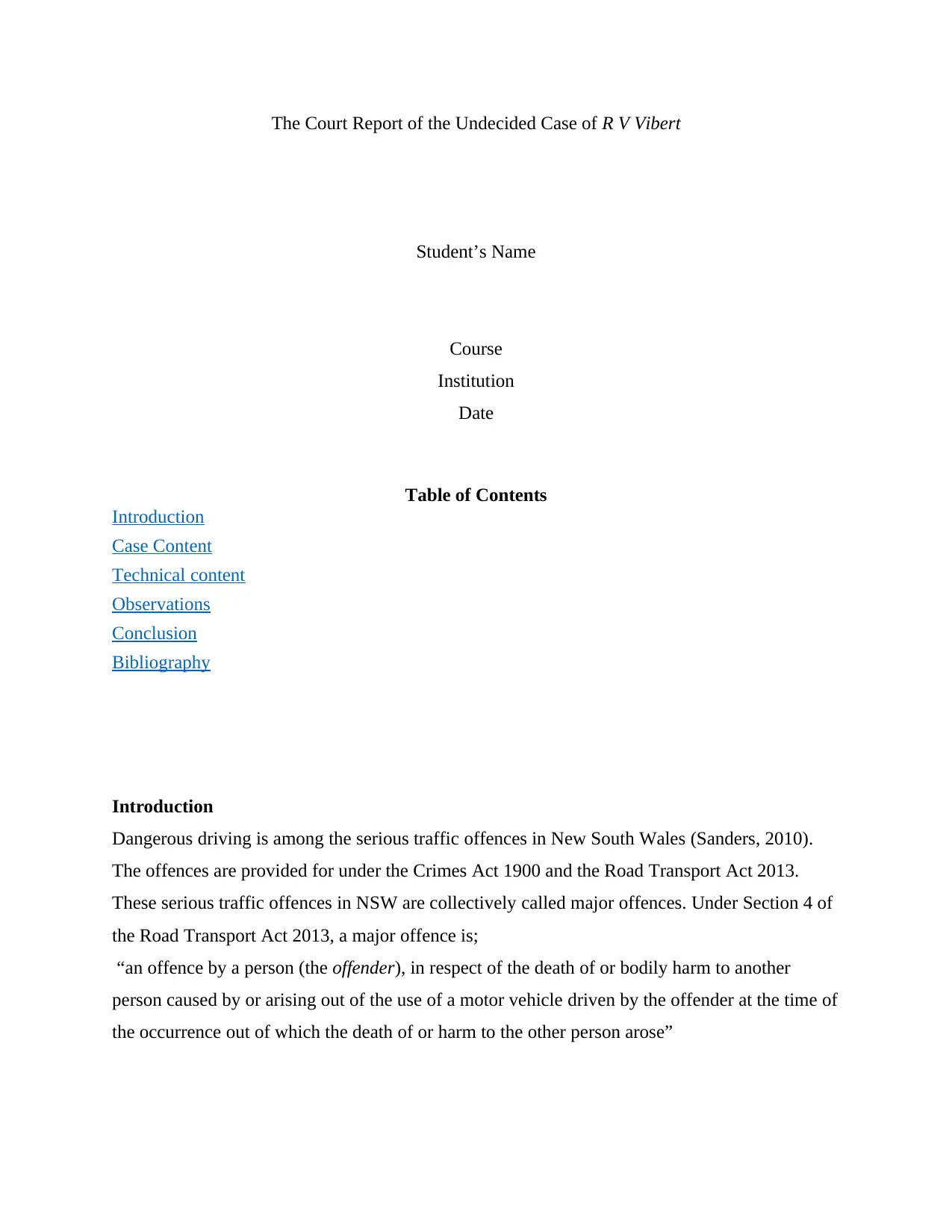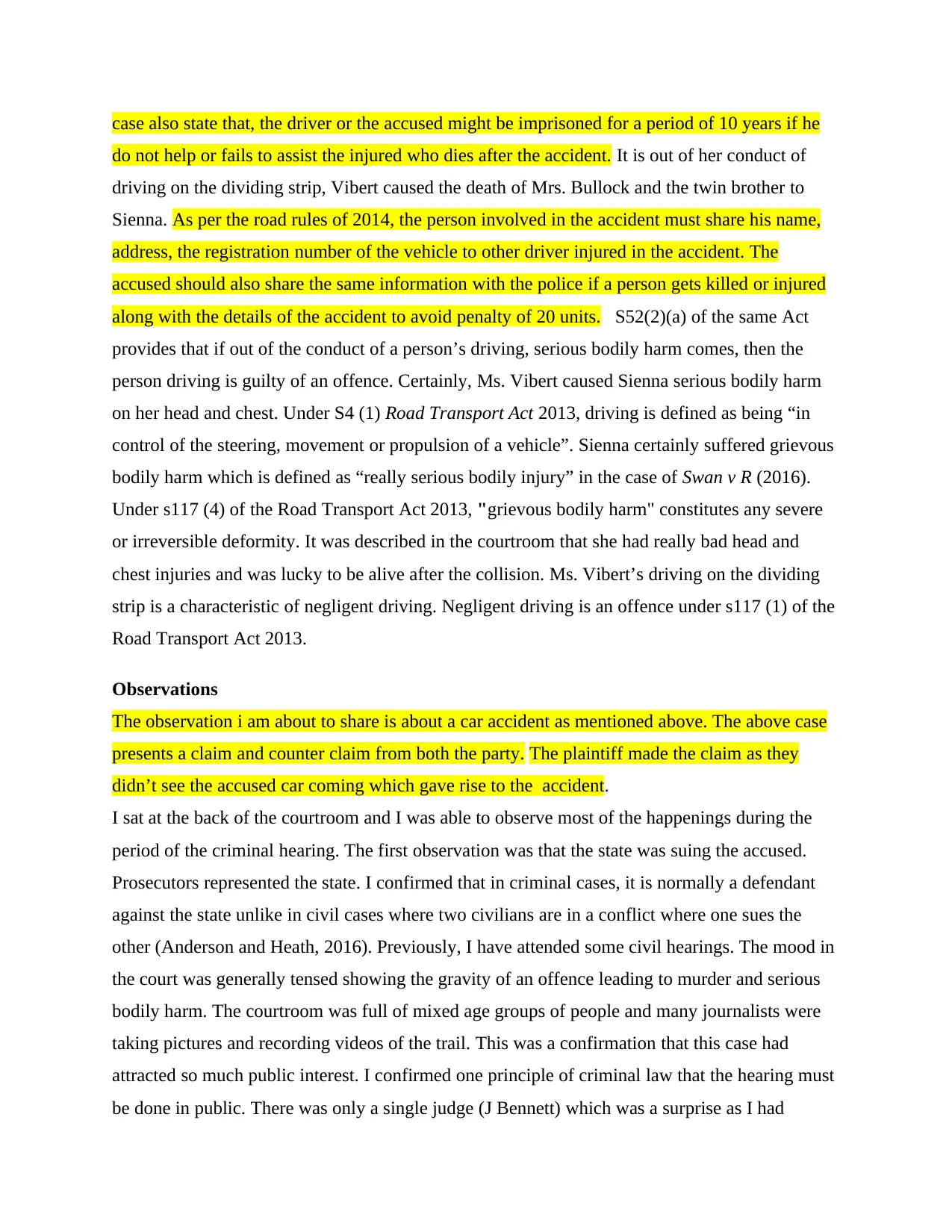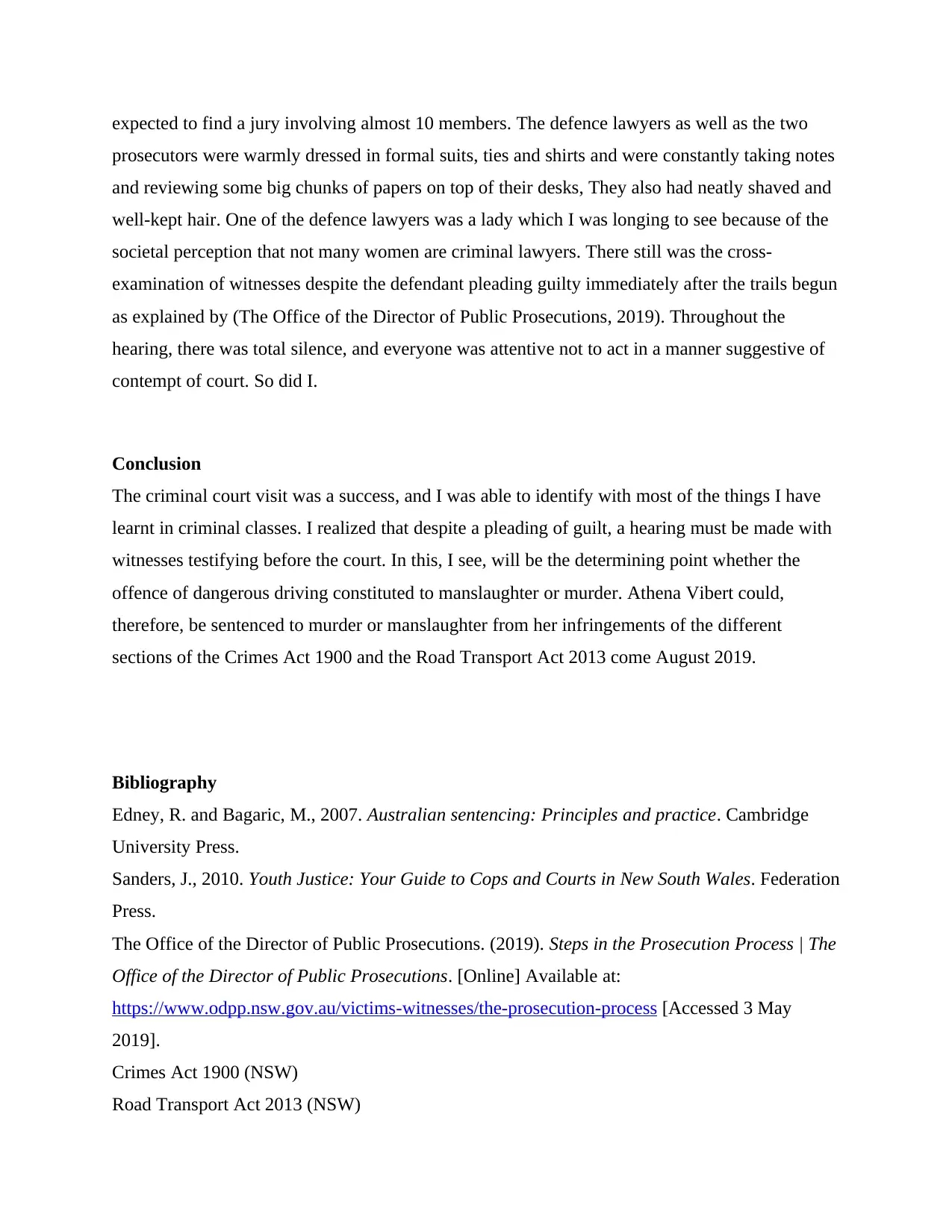Detailed Court Report: The Undecided Case of R V Vibert - NSW
VerifiedAdded on 2023/01/11
|5
|1517
|73
Report
AI Summary
This court report provides a detailed analysis of the R V Vibert case heard at Parramatta District Court. The case involves Athena Vibert, accused of dangerous driving resulting in the death of a mother and son, and causing grievous bodily harm to a daughter. The report covers the case content, including the incident on the Hume Motorway, the charges (dangerous driving, negligent driving, and driving on the dividing strip), and the defendant's guilty pleas. It delves into the technical aspects, citing relevant sections of the Crimes Act 1900 and the Road Transport Act 2013, defining key terms like 'grievous bodily harm' and the responsibilities of drivers involved in accidents. Observations from the courtroom, including the tense atmosphere, the presence of media, and the single judge presiding, are also discussed. The report concludes with an assessment of the case's potential outcomes, highlighting the possibility of sentencing for manslaughter or murder based on the legal infringements. The report is supported by a bibliography of cited legal references.

The Court Report of the Undecided Case of R V Vibert
Student’s Name
Course
Institution
Date
Table of Contents
Introduction
Case Content
Technical content
Observations
Conclusion
Bibliography
Introduction
Dangerous driving is among the serious traffic offences in New South Wales (Sanders, 2010).
The offences are provided for under the Crimes Act 1900 and the Road Transport Act 2013.
These serious traffic offences in NSW are collectively called major offences. Under Section 4 of
the Road Transport Act 2013, a major offence is;
“an offence by a person (the offender), in respect of the death of or bodily harm to another
person caused by or arising out of the use of a motor vehicle driven by the offender at the time of
the occurrence out of which the death of or harm to the other person arose”
Student’s Name
Course
Institution
Date
Table of Contents
Introduction
Case Content
Technical content
Observations
Conclusion
Bibliography
Introduction
Dangerous driving is among the serious traffic offences in New South Wales (Sanders, 2010).
The offences are provided for under the Crimes Act 1900 and the Road Transport Act 2013.
These serious traffic offences in NSW are collectively called major offences. Under Section 4 of
the Road Transport Act 2013, a major offence is;
“an offence by a person (the offender), in respect of the death of or bodily harm to another
person caused by or arising out of the use of a motor vehicle driven by the offender at the time of
the occurrence out of which the death of or harm to the other person arose”
Paraphrase This Document
Need a fresh take? Get an instant paraphrase of this document with our AI Paraphraser

An offender of any crime of that kind is either convicted of manslaughter or murder after trial
(Edney, and Bagaric, 2007. This court report will be looking at an accused person who was
charged with the offence of dangerous driving among other counts of traffic offences.
Case Content
I went at Parramatta District Court on the 29th of April 2019 at 9:30 am. Parramatta District
Court is a district court in NSW that has the jurisdiction of hearing serious criminal cases. The
judge’s name was J Bennett. The trial before the court was a criminal case involving an offender
accused of major traffic offence of dangerous driving by the name Athena Vibert from Balmoral,
who is now 52 years. Athena Vibert was accused of killing killed a mother (Julie Bullock) and
her son on March 7 2017, just before 8 am. Ms. Vibert was driving a silver Holden Astra and it
was alleged that she swerved across the median strip on the Hume Motorway where he crashed
head-on with the family of Mrs. Bullock leaving both cars mangled wrecks. The accused person
also got injured and had been hospitalized at Liverpool Hospital for several days. The crash took
place about 1 km south of the Picton Road- off. Mrs. Bullock had a daughter (Sienna) in her
four-wheel drive car who survived the accident but with severe injuries on her head and Chest.
The son did not die immediately after the accident but later at Liverpool Hospital where he had
been taken in a critical condition. Vibert was first prosecuted at Picton Local Court House. Ms.
Vibert was charged with other counts; negligent driving, driving occasioning grievous bodily
harm (Sienna), and driving on the dividing strip. After having previously made two pleas of not
guilty on two counts on July last year (2018), and in an unanticipated twist of events, on the 29th
of April 2019, Athena Vibert entered three guilty pleas and is now scheduled for a verdict on
August 28th 2019. The accused claimed that he too was injured in the accident and it was not his
fault completely. He also stated that he didn’t run from the crime scene which shows he was not
intentionally involved in the accident.
Technical content
Athena Vibert violated the s52A(1)a Crimes Act 1900 that provides that one is guilty of an
offence if the car he is driving gets into an impact that results in the death of another person. The
(Edney, and Bagaric, 2007. This court report will be looking at an accused person who was
charged with the offence of dangerous driving among other counts of traffic offences.
Case Content
I went at Parramatta District Court on the 29th of April 2019 at 9:30 am. Parramatta District
Court is a district court in NSW that has the jurisdiction of hearing serious criminal cases. The
judge’s name was J Bennett. The trial before the court was a criminal case involving an offender
accused of major traffic offence of dangerous driving by the name Athena Vibert from Balmoral,
who is now 52 years. Athena Vibert was accused of killing killed a mother (Julie Bullock) and
her son on March 7 2017, just before 8 am. Ms. Vibert was driving a silver Holden Astra and it
was alleged that she swerved across the median strip on the Hume Motorway where he crashed
head-on with the family of Mrs. Bullock leaving both cars mangled wrecks. The accused person
also got injured and had been hospitalized at Liverpool Hospital for several days. The crash took
place about 1 km south of the Picton Road- off. Mrs. Bullock had a daughter (Sienna) in her
four-wheel drive car who survived the accident but with severe injuries on her head and Chest.
The son did not die immediately after the accident but later at Liverpool Hospital where he had
been taken in a critical condition. Vibert was first prosecuted at Picton Local Court House. Ms.
Vibert was charged with other counts; negligent driving, driving occasioning grievous bodily
harm (Sienna), and driving on the dividing strip. After having previously made two pleas of not
guilty on two counts on July last year (2018), and in an unanticipated twist of events, on the 29th
of April 2019, Athena Vibert entered three guilty pleas and is now scheduled for a verdict on
August 28th 2019. The accused claimed that he too was injured in the accident and it was not his
fault completely. He also stated that he didn’t run from the crime scene which shows he was not
intentionally involved in the accident.
Technical content
Athena Vibert violated the s52A(1)a Crimes Act 1900 that provides that one is guilty of an
offence if the car he is driving gets into an impact that results in the death of another person. The

case also state that, the driver or the accused might be imprisoned for a period of 10 years if he
do not help or fails to assist the injured who dies after the accident. It is out of her conduct of
driving on the dividing strip, Vibert caused the death of Mrs. Bullock and the twin brother to
Sienna. As per the road rules of 2014, the person involved in the accident must share his name,
address, the registration number of the vehicle to other driver injured in the accident. The
accused should also share the same information with the police if a person gets killed or injured
along with the details of the accident to avoid penalty of 20 units. S52(2)(a) of the same Act
provides that if out of the conduct of a person’s driving, serious bodily harm comes, then the
person driving is guilty of an offence. Certainly, Ms. Vibert caused Sienna serious bodily harm
on her head and chest. Under S4 (1) Road Transport Act 2013, driving is defined as being “in
control of the steering, movement or propulsion of a vehicle”. Sienna certainly suffered grievous
bodily harm which is defined as “really serious bodily injury” in the case of Swan v R (2016).
Under s117 (4) of the Road Transport Act 2013, "grievous bodily harm" constitutes any severe
or irreversible deformity. It was described in the courtroom that she had really bad head and
chest injuries and was lucky to be alive after the collision. Ms. Vibert’s driving on the dividing
strip is a characteristic of negligent driving. Negligent driving is an offence under s117 (1) of the
Road Transport Act 2013.
Observations
The observation i am about to share is about a car accident as mentioned above. The above case
presents a claim and counter claim from both the party. The plaintiff made the claim as they
didn’t see the accused car coming which gave rise to the accident.
I sat at the back of the courtroom and I was able to observe most of the happenings during the
period of the criminal hearing. The first observation was that the state was suing the accused.
Prosecutors represented the state. I confirmed that in criminal cases, it is normally a defendant
against the state unlike in civil cases where two civilians are in a conflict where one sues the
other (Anderson and Heath, 2016). Previously, I have attended some civil hearings. The mood in
the court was generally tensed showing the gravity of an offence leading to murder and serious
bodily harm. The courtroom was full of mixed age groups of people and many journalists were
taking pictures and recording videos of the trail. This was a confirmation that this case had
attracted so much public interest. I confirmed one principle of criminal law that the hearing must
be done in public. There was only a single judge (J Bennett) which was a surprise as I had
do not help or fails to assist the injured who dies after the accident. It is out of her conduct of
driving on the dividing strip, Vibert caused the death of Mrs. Bullock and the twin brother to
Sienna. As per the road rules of 2014, the person involved in the accident must share his name,
address, the registration number of the vehicle to other driver injured in the accident. The
accused should also share the same information with the police if a person gets killed or injured
along with the details of the accident to avoid penalty of 20 units. S52(2)(a) of the same Act
provides that if out of the conduct of a person’s driving, serious bodily harm comes, then the
person driving is guilty of an offence. Certainly, Ms. Vibert caused Sienna serious bodily harm
on her head and chest. Under S4 (1) Road Transport Act 2013, driving is defined as being “in
control of the steering, movement or propulsion of a vehicle”. Sienna certainly suffered grievous
bodily harm which is defined as “really serious bodily injury” in the case of Swan v R (2016).
Under s117 (4) of the Road Transport Act 2013, "grievous bodily harm" constitutes any severe
or irreversible deformity. It was described in the courtroom that she had really bad head and
chest injuries and was lucky to be alive after the collision. Ms. Vibert’s driving on the dividing
strip is a characteristic of negligent driving. Negligent driving is an offence under s117 (1) of the
Road Transport Act 2013.
Observations
The observation i am about to share is about a car accident as mentioned above. The above case
presents a claim and counter claim from both the party. The plaintiff made the claim as they
didn’t see the accused car coming which gave rise to the accident.
I sat at the back of the courtroom and I was able to observe most of the happenings during the
period of the criminal hearing. The first observation was that the state was suing the accused.
Prosecutors represented the state. I confirmed that in criminal cases, it is normally a defendant
against the state unlike in civil cases where two civilians are in a conflict where one sues the
other (Anderson and Heath, 2016). Previously, I have attended some civil hearings. The mood in
the court was generally tensed showing the gravity of an offence leading to murder and serious
bodily harm. The courtroom was full of mixed age groups of people and many journalists were
taking pictures and recording videos of the trail. This was a confirmation that this case had
attracted so much public interest. I confirmed one principle of criminal law that the hearing must
be done in public. There was only a single judge (J Bennett) which was a surprise as I had
⊘ This is a preview!⊘
Do you want full access?
Subscribe today to unlock all pages.

Trusted by 1+ million students worldwide

expected to find a jury involving almost 10 members. The defence lawyers as well as the two
prosecutors were warmly dressed in formal suits, ties and shirts and were constantly taking notes
and reviewing some big chunks of papers on top of their desks, They also had neatly shaved and
well-kept hair. One of the defence lawyers was a lady which I was longing to see because of the
societal perception that not many women are criminal lawyers. There still was the cross-
examination of witnesses despite the defendant pleading guilty immediately after the trails begun
as explained by (The Office of the Director of Public Prosecutions, 2019). Throughout the
hearing, there was total silence, and everyone was attentive not to act in a manner suggestive of
contempt of court. So did I.
Conclusion
The criminal court visit was a success, and I was able to identify with most of the things I have
learnt in criminal classes. I realized that despite a pleading of guilt, a hearing must be made with
witnesses testifying before the court. In this, I see, will be the determining point whether the
offence of dangerous driving constituted to manslaughter or murder. Athena Vibert could,
therefore, be sentenced to murder or manslaughter from her infringements of the different
sections of the Crimes Act 1900 and the Road Transport Act 2013 come August 2019.
Bibliography
Edney, R. and Bagaric, M., 2007. Australian sentencing: Principles and practice. Cambridge
University Press.
Sanders, J., 2010. Youth Justice: Your Guide to Cops and Courts in New South Wales. Federation
Press.
The Office of the Director of Public Prosecutions. (2019). Steps in the Prosecution Process | The
Office of the Director of Public Prosecutions. [Online] Available at:
https://www.odpp.nsw.gov.au/victims-witnesses/the-prosecution-process [Accessed 3 May
2019].
Crimes Act 1900 (NSW)
Road Transport Act 2013 (NSW)
prosecutors were warmly dressed in formal suits, ties and shirts and were constantly taking notes
and reviewing some big chunks of papers on top of their desks, They also had neatly shaved and
well-kept hair. One of the defence lawyers was a lady which I was longing to see because of the
societal perception that not many women are criminal lawyers. There still was the cross-
examination of witnesses despite the defendant pleading guilty immediately after the trails begun
as explained by (The Office of the Director of Public Prosecutions, 2019). Throughout the
hearing, there was total silence, and everyone was attentive not to act in a manner suggestive of
contempt of court. So did I.
Conclusion
The criminal court visit was a success, and I was able to identify with most of the things I have
learnt in criminal classes. I realized that despite a pleading of guilt, a hearing must be made with
witnesses testifying before the court. In this, I see, will be the determining point whether the
offence of dangerous driving constituted to manslaughter or murder. Athena Vibert could,
therefore, be sentenced to murder or manslaughter from her infringements of the different
sections of the Crimes Act 1900 and the Road Transport Act 2013 come August 2019.
Bibliography
Edney, R. and Bagaric, M., 2007. Australian sentencing: Principles and practice. Cambridge
University Press.
Sanders, J., 2010. Youth Justice: Your Guide to Cops and Courts in New South Wales. Federation
Press.
The Office of the Director of Public Prosecutions. (2019). Steps in the Prosecution Process | The
Office of the Director of Public Prosecutions. [Online] Available at:
https://www.odpp.nsw.gov.au/victims-witnesses/the-prosecution-process [Accessed 3 May
2019].
Crimes Act 1900 (NSW)
Road Transport Act 2013 (NSW)
Paraphrase This Document
Need a fresh take? Get an instant paraphrase of this document with our AI Paraphraser

1 out of 5
Your All-in-One AI-Powered Toolkit for Academic Success.
+13062052269
info@desklib.com
Available 24*7 on WhatsApp / Email
![[object Object]](/_next/static/media/star-bottom.7253800d.svg)
Unlock your academic potential
Copyright © 2020–2025 A2Z Services. All Rights Reserved. Developed and managed by ZUCOL.
